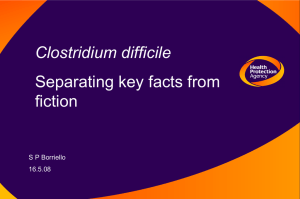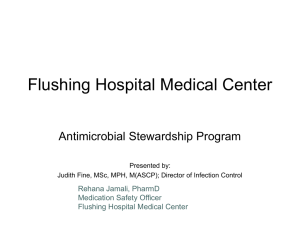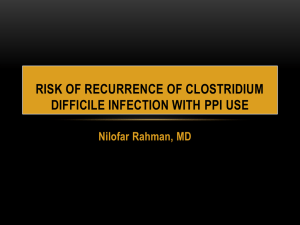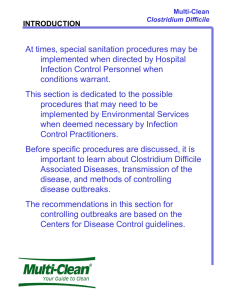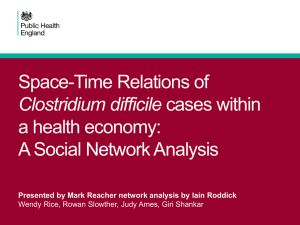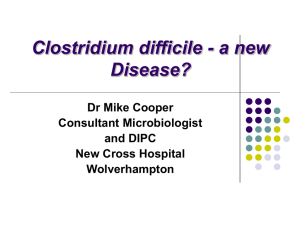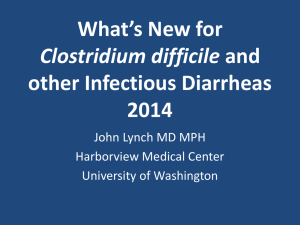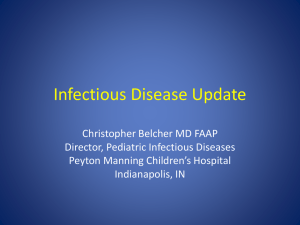Gilligan Bio Lecture
advertisement
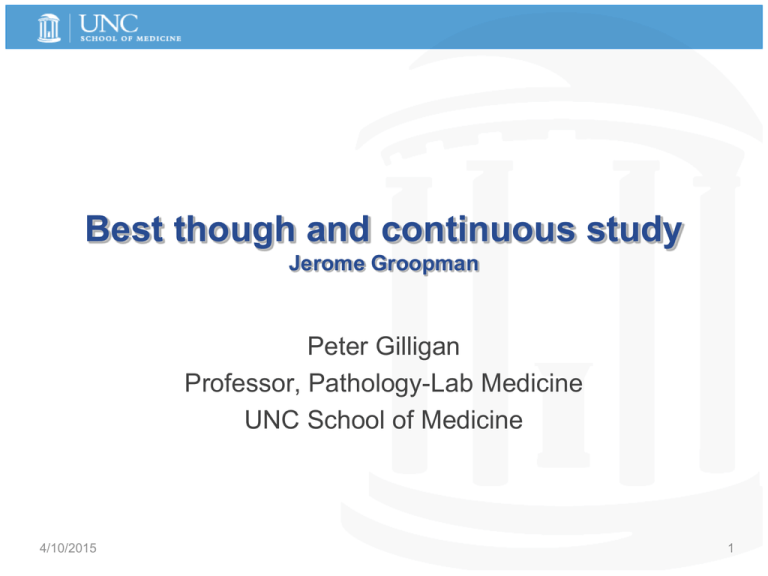
Best though and continuous study Jerome Groopman Peter Gilligan Professor, Pathology-Lab Medicine UNC School of Medicine 4/10/2015 1 How I became a clinical microbiologist • Obtained doctoral degree in microbiology at the University of Kansas • Did post-doctoral training (2 years) in medical and public health microbiology at UNC Hospitals • Director of Microbiology Labs at St Christopher’s Hospital for Children (Philadelphia) for 4 years • Past 25+ years, Associate Director then Director of the Clinical Microbiology-Immunology Labs at UNC Hospitals 4/10/2015 2 What do clinical microbiologists do? • We serve: » our patients » our health care-providing colleagues, physicians, nurses, physician assistants, pharmacy colleagues » hospital administrators • We make money for the institution » general public by insuring the public health • Involved in studying outbreaks of several emerging infectious diseases including current fungal meningitis one • will tell you about an emerging pathogens todayClostridium difficile 4/10/2015 3 How do we serve? • central role in the diagnosis and management of infectious diseases • central role in infection prevention and antimicrobial use • recognize emerging disease threats and outbreaks including bioterrorism events • we educate & train health care providers • we create new knowledge (research) to deal with practical problems 4/10/2015 4 Best things about my job • Direct impact on patient care and public health of the community • Intellectually challenging job requiring a broad fund of knowledge-need to know a little about a lot of things –I am never bored!!!!!!! • Get to work with cutting edge technology • Work with highly motivated and intelligent individuals • Get to be at the cutting edge of infectious disease diagnosis • I am involved in global issues as they relate to infectious diseases 4/10/2015 5 Worst things about my job • Incredible amounts of governmental oversight • Increasing emphasis on financial aspects of the job • Declining talent pool of technologists-THIS A GREAT JOB MARKET FOR YOU WITH APPROPRIATE TRAINING • Too much travel • Need to be responsible for an organization that run 24/7/365-we never close. Personally have worked through ice storms, blizzards, and hurricanes. 4/10/2015 6 How you can become a clinical microbiologist • CLS programs available here, ECU, WSSU, Wake Forest, UNC-CH » Education is also available on line • 2 more years of school to get a BS in CLS » There is no unemployment in this group • Take ASCP certification exam to become certified as a MT. » Starting salary is 41,000 and up » Career options are amazingly diverse; many former UNC students work in leadership positions in the pharmaceutical and biotech industries- Also have 5 former employees 4/10/2015 currently in Med, Grad, Pharmacy School 7 Emerging Infectious Diseases in the Past 30 Years • • • • • • • • • • • • • • • • • • • • Clostridium difficile*# novel H1N1 influenza AHIV*# SARS and MERS CoV* Cryptosporidium* E. coli O157:H7*# Nipah virus nv Creutzfeldt-Jakob disease Sin Nombre Virus West Nile Virus Vibrio vulnificus* Cyclospora Bacillus anthracis #(BT agent) CA-ORSA*# TSST-1 S. aureus*# XDR- and MDR-TB* MDR- pneumococcus*# MDR-Acinetobacter* Rapidly growing mycobacterium*# Campylobacter*# ESBL-Enterobactericeae* 4/10/2015 • • • • • • • • • • • • • • • • • • • • Rotavirus* Norovirus* BK virus* Chlamydophila pneumoniae Penicillium marneffei Legionella* Burkholderia cepacia complex*# Burkholderia gladioli*# VRE*#/VRSA Helicobacter pylori* HHV-6* HPV* HCV* Avian influenza (H5N1) Ehrlichia chaffenesis* Borrelia burgdorferi* (Lyme disease) Enterotoxigenic E. coli# Enteroadherent E. coli* Bordetella avium Microsporidium* 8 Clostridium difficile • General characteristics » Gram positive rod » Spore former » Anaerobic » Can be part of human microflora » Pathogenicity due to the production of two protein exotoxins A and B Chance favors only the prepared mind Louis Pasteur Key events in the discovery of C. difficile • Larson and colleagues describe a toxin in the feces of a child with pseudomembranous colitis (1977) • Bartlett and colleagues show that C difficile can induce colitis in hamsters given clindamycin and then a variety of antibiotics and then proves that the organism can cause the same disease in humans (1978) » Serendipity is important- showed that C. sordellii antitoxin could neutralize toxins produced by C. difficile in a tissue culture cytotoxicity assay. Key events in the discovery of C. difficile • Among others, Gilligan and colleagues show that C. difficile is the most common bacterial agent in a general population (1980) • Lyerly and colleagues purify two toxins, A and B, from C. difficile and also produce an important anti-toxin against these organisms (1982) US deaths due to C. difficle has increased 2.3X since 2000 ; mortality 4% Peery et al, 2012 Gastroenterology (in press) Nature Reviews Gastroenterology & Hepatology 8, 17-26 (January 2011) Top Ten Pathogens Causing Healthcare Associated Infections, 2011 300 Number of Pathogens 250 200 150 100 50 0 What makes C difficile an important pathogen in the industrialized world? • Important ideas » Organism can survive in the environment for months as spores; spores are refractory to disinfectants especially alcohol and all antimicrobials » Alternation in the gut flora is important in predisposing patient’s to disease with this organism- antibiotics mediate this change • Microbiome is less diverse » Most common diarrheal disease etiology in the industrialized world requiring specific antimicrobial interventions Age related C. difficile incidence in US What factors has resulted in the reemergence of Clostridium difficile?? • Better case ascertainment » Improvement in lab diagnosis • Aging population » Decline in Bifidobacterium with age, an organism important in colonization resistance, in gut flora may create more permissive environment for C. difficile • Increased use of antimicrobials especially fluoroquinolones with anti-anaerobic activity to which C. difficile is resistant » This is being debated in the infectious disease community » 90% of C. difficile isolates are fluoroquinolone resistant What factors has resulted in the reemergence of Clostridium difficile? • Increased contamination of health care setting with C. difficile spores making infections more likely » Cleanliness of British Public Health Service hospitals has become a major political issue there • Shared rooms and bathroom facilities » Particular issue in Canada and Britain Pathogenesis of C. difficile • Key steps in pathogenesis » Anaerobic gut flora confers “colonization resistance” to the host from infection with C. difficile » Alteration of this gut flora by antimicrobial therapy creates a permissive environment for the vegetation of C. difficile spores » Spores are either present in gut at time of alteration of gut flora or are obtained from the hospital environment during the period of gut flora alteration • May take as long as six weeks for gut flora to return to normal • Antimicrobials most impacting gut flora include clindamycin, cephalosporins, and perhaps newer fluoroquinolones Pathogenesis of C. difficile • Organism grows and begins to produce both toxin A & B » Toxins have high degree of sequence similarity • Toxins bind to specific receptors on surface of the cell and enter cell via receptor mediated endocytosis • Toxins acts as a glucosyltransferase inactivating small GTPase Pathogenesis of C. difficile • GTPase control a variety of cell functions resulting in: - actin condensation which leads to cell rounding, membrane blebbing, apoptosis, and cell death » increased permeability of the colonic epithelium » chemokine expression which increases inflammatory response » increases neutrophil infiltration » loss of tight junctions resulting in neutrophil migration into the intestine Clostridium difficile PMC and toxic megacolon C. difficile: Spectrum of disease Asymptomatic carriage Mild diarrhea Profuse diarrhea with non-specific colitis Pseudomembranous colitis Toxic megacolon frequency Rules for C. difficile testing • If the stick stands, the test is banned (type 15) » High carriage rate in patients on antimicrobials • If the stick falls, test them all. (type 6 + 7) Dr. Stephen Brecher 4/10/2015 26 Report as positive for C. difficile Report as negative for C. difficile Based on data in literature of PVP >95% for CDI If NAAT for C. difficile toxin gene is positive, report as positive for C. difficile. If NAAT for C. difficile toxin gene is negative, report as negative as C. difficile UK algorithms GDH/NAAT negative-report as CDI unlikely GDH/NAAT positive; toxin positive- CDI likely GDH/NAAT positive; toxin negative- C. difficile present; C. difficile excretor Rationale is GDH/NAAT positive; toxin positive-worse outcome- CTN test superior to toxin EIA Applying the UK algorithm • Using our data and a three step algorithm • 87.6% are GDH/PCR negative- no CDI • 7.9% are PCR pos/toxin negative- C. difficile excretor • 4.4% GDH/toxin positive-CDI What does “C. difficile execretor” mean? Likely be a clinical decision with infection prevention ramifications Bottom line: Need to treat the patient not the laboratory test Infection Rate (Number of Infections Per 1000 Patient Days) 0.9 UNC Healthcare-associated infection rates: C. difficile 0.8 0.7 0.6 0.5 0.4 0.3 0.2 Switched to GDH/PCR algorithm 0.1 0 2003 2004 2005 2006 2007 2008 Year 2009 2010 2011 4/10/2015 32 4/10/2015 33 Changing deaths in UK due to C. difficile 4/10/2015 34 Treatment of C. difficile disease • Initial studies showed that metronidazole and vancomycin had similar initial response to therapy (90%) and similar disease recurrence rates (5 to 12%) • Metronidazole became the drug of choice because it was much cheaper and because of concerns of vancomycin use resulting in increased rates of VRE and concerns about the emergence of VRSA • Fidaxomicin is a new drug that is used to mainly recurrence of C. difficile infection Treatment of C. difficile disease • Two studies (published 6/05) showed much higher rates of treatment failures/recurrences than previously reported with metronidazole » One study (CID 40:1586, 2005) only 50% of patients were cured, 22% had symptoms continuous for > 10 days and 28% had recurrences » In a Canadian survey (Pepin et al. CID 40:1591-7), recurrence rates increased from 21% in 1991-2002 to 48% in 2003-2004; in those over 65 y.o., that rate was close to 60% in 2003-4 The problem of recurrence of C. difficile disease • Molecular epidemiology studies have shown that recurrences of C. difficile can be: » due to relapse- a second or third episode of C. difficile due to the patients own organism or » re-infection obtaining a new strain from the patient’s environment. (each occurs in approximately 50% of patients) » Failure to develop colonization resistance and mount an immune response thought to play a crucial role in recurrences The problem of recurrence of C. difficile disease » fecal microbiota transplant • Donor stool from healthy family member • re-populate gut via colonoscopy (75%) or naso-gastric tube (25%) • 91% efficacy based on data from over 300 patients • Done at UNC » Use of probiotics such as lactobacilli or Saccharomyces has not been particularly impressive to date in repopulating the gut to prevent recurrences Final thought: In patients with C. difficile disease, remember to wash your hands with soap and water; not alcohol gels

